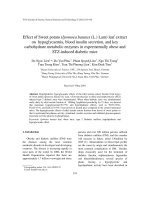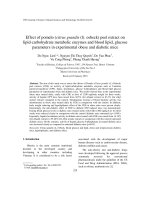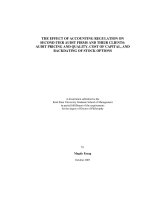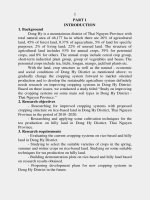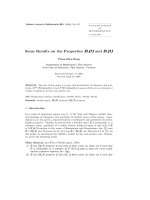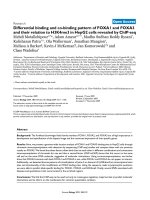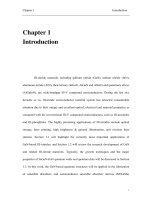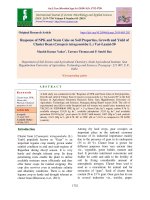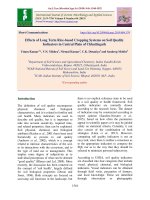Impact of mountain cropping systems on soil properties, nutrient availability and their carbon sequestration potential in mid-hills of Himachal Pradesh, India
Bạn đang xem bản rút gọn của tài liệu. Xem và tải ngay bản đầy đủ của tài liệu tại đây (190.52 KB, 9 trang )
Int.J.Curr.Microbiol.App.Sci (2017) 6(4): 203-211
International Journal of Current Microbiology and Applied Sciences
ISSN: 2319-7706 Volume 6 Number 4 (2017) pp. 203-211
Journal homepage:
Original Research Article
/>
Impact of Mountain Cropping Systems on Soil Properties, Nutrient
Availability and Their Carbon Sequestration Potential in Mid-Hills of
Himachal Pradesh, India
C.K. Ndungu*, S.K. Bhardwaj and L. Nancy
Department of Environmental Science, Dr. Y S Parmar University of Horticulture
and Forestry, Nauni (Solan) India
*Corresponding author
ABSTRACT
Keywords
Cereal crops,
Vegetable crops,
Fruit crops,
Agroforestry,
NPK, Adaptation,
Mitigation.
Article Info
Accepted:
02 March 2017
Available Online:
10 April 2017
The impact of mountain cropping systems on soil properties, nutrient availability and soil
carbon sequestration potential was studied during the years 2014 and 2015 in mid-hills of
Himachal Pradesh. The four commonly occurring cropping systems namely vegetable,
fruit, cereal crop and agroforestry were selected. Barren land in the region was considered
as control. In total, there were five treatments which were replicated six times under
randomized block design. The study indicated that the mountain cropping systems varied
significantly (p<0.05) with respect to their impact on soil properties, nutrient availability
and carbon sequestration potential. The pH and EC was in the range of 6.30 to 6.95 and
0.58 to 0.66 dSm-1, respectively and were in normal range. Soil organic carbon and bulk
density in surface soil ranged from 0.83 to 1.75% and 1.25 to 1.27 Mg m -3, respectively.
The status of NPK was also noticed to vary among the cropping systems. Available
nitrogen was highest in vegetable (555.45 kg ha-1) while available phosphorous and
potassium were highest in fruit cropping system with respective values of 43.96 and
451.12 kg ha-1. Carbon density in surface soil ranged from 10.71 to 20.60 Mg C ha -1 and
total carbon sequestered up to 30cm depth ranged from 1021.52 to 9395.66 Gg. The study
indicated that in mid-hills of Himachal Pradesh, the commonly occurring cropping systems
did not influence the soil properties and nutrient availability adversely. Fruit based
cropping system was noticed to have the highest potential of sequestering soil carbon in
the region. Therefore to adapt to changing climatic situation and to mitigate its effect in the
region, fruit based cropping system need to be encouraged.
Introduction
The productivity of our planet’s ecosystems
depends upon the nature of the soil and its
quality.
The
crop
production
and
environmental quality can be sustained by
maintaining this important natural resource on
sustainable basis. However, to meet the
increasing demand of burgeoning population,
agriculture
is
being
commercialised
everywhere and it has become a high input
system. The high input systems have now
started impacting soil quality and ultimately
the nature of ecosystem services (Feng et al.,
2010). Moreover, the commercialization of
agriculture has led to adoption of high
yielding crop varieties whereby one type of
crop is continuously cultivated on one plot in
an attempt to increase yields. This
monoculture farming system interferes with
203
Int.J.Curr.Microbiol.App.Sci (2017) 6(4): 203-211
the soil’s ability to provide essential
ecosystem services such as soil health and
carbon sequestration. The monoculture
farming reduces soil carbon, promotes
adverse soil reactions and ultimately reduces
nutrient availability.
adoption of high input demanding cropping
systems on steep and sloppy areas, thereby
exposing the region to various environmental
problems. Therefore, the current study was
conceived with the objective of exploring the
impacts of cropping systems on soil quality
and its carbon sequestration potential in the
region.
In recent years a concern is being expressed at
global level that chemical based energy
intensive modern agriculture is threatening
the natural resource systems through
contamination of soil and water bodies, global
warming and ecological degradation. In India,
the green revolution technologies during the
last few decades have helped to achieve selfregulating sufficiency in food grain
production, but emergent of many new and
unexpected problems have created a spectre
of unsustainability in cropping systems. These
problems are related to emergence of nutrient
deficiencies,
soil
and
environmental
degradation. To address these issues and the
long term impact of different cropping
systems, the assessment of their long term
impact on soil and environmental quality is
now being stressed.
Materials and Methods
Study area
The study area consisted of mid-hill (8001600 m above mean sea level) regions falling
in two districts namely Kullu and Solan of
Himachal Pradesh in North Western
Himalayas. The region has mild temperate
climate with annual average rainfall of about
1150 mm. The soils vary from sandy loam to
loam in texture. The area has a steep and
rugged terrain which amplifies biophysical
and socioeconomic vulnerability of the
communities. The mid-hills cover an area of
about 33% of the total geographical area and
53% of the cultivated area of the state. The
study area selected in mid-hills of Kullu and
Solan districts of HP is depicted in figure 1.
Agriculture soils are among the planet’s
largest reservoirs of carbon and hold potential
for expanded carbon sequestration and thus
provide a prospective way of mitigating the
increasing atmospheric concentration of
carbon dioxide. It is estimated that soils can
sequester around 20 Pg C in 25 years, more
than 10% of the anthropogenic emissions (Liu
et al., 2005). At the same time, soil organic
carbon provides other benefits for soil, crop,
environmental quality, enhancement of
biodiversity and prevention of erosion and
desertification.
Cropping systems and experimental details
The four cropping systems i.e. fruit,
vegetable, cereal and agroforestry based were
selected in mid-hills of Kullu and Solan
districts of Himachal Pradesh. The selected
systems were replicated six times and barren
land was considered as control. The study was
conducted under randomized block design,
with five treatments.
The fruit farming system was composed of
apple, apricot, pomegranate or peach crops.
The vegetable farming system was composed
of cabbage, capsicum or potato crops. Cereal
based farming system was maize and wheat
based while agroforestry system was
composed of agri-silviculture or agri-
In the recent past, dramatic changes in the
agricultural land use and associated
management practices have happened in midhills of Himachal Pradesh. Increasing
commercialisation of agriculture and spread
of market oriented horticulture has led to
204
Int.J.Curr.Microbiol.App.Sci (2017) 6(4): 203-211
ha-1) was computed by multiplying the soil
carbon content (%) with bulky density Di (g
m3), volume fraction of coarse fragments Gi
and depth Ei (m) and expressed as Mg C ha-1
as per the following formula given by Batjes
(1996).
horticulture. The total area under vegetable,
fruit, cereal and agroforestry system was
about 44249.7ha, 113724ha, 410866ha and
121900ha, respectively whereas it was
258523.2ha as barren land in mid-hills of
Himachal Pradesh (Anonymous, 2012).
Amongst the four dominant cropping systems
in mid-hills of Himachal Pradesh, the cereal
based and agroforestry were the oldest
systems and are being followed by the
mountain people for the last about 50 years.
On the other hand fruit and vegetable based
cropping system are being practiced for the
last 30 and 15 years, respectively. Vegetable
cropping system was noticed to be the recent
one, having been followed by the farmers for
the last 15 years. Among the selected
cropping systems, fruit and vegetable systems
were noticed to be high input based wherein
farm yard manure and NPK fertilizers are
applied at a rate of 900-1000 kg ha-1 and
700:350:700g per tree- 200:112.5:75 kg ha-1,
respectively.
QI=CiDiEi (1-Gi)
The total amount of carbon sequestered by
each cropping system in mid-hills of Kullu
and Solan districts of Himachal Pradesh was
computed by multiplying the mean carbon
stock per hectare by the total area.
Statistical analysis
Analysis of variance (ANOVA) was used to
evaluate the influence of cropping systems on
soil physical chemical properties, nutrient
contents and carbon stocks in mid-hills of
Himachal Pradesh. The means were separated
and compared through critical difference at
5% level of significance. In order to depict the
long term impact of cropping systems on the
soil properties and soil carbon stock the data
with respect to the various parameters was
pooled for both the years.
Soil sampling and analysis
Composite soil samples from surface and subsurface layers were taken from each cropping
system during year 2014 and 2015 and
transported to the laboratory for processing
and analysis. Soil samples were air dried,
ground and sieved (2mm) before laboratory
examination. The soil bulk density was
estimated by core method (Singh, 1980). Soil
organic carbon was determined by rapid
titration method (Walkley and Black, 1934).
The available nitrogen was estimated by
alkaline potassium permanganate method
(Subbiah and Asijia, 1956) and available
phosphorus by using Olsen’s method (Olsen
et al., 1954). The available potassium was
estimated by ammonium acetate method
(Merwin and Peech, 1951). Soil electrical
conductivity and pH was determined by 1:2.5
soil: water suspension method (Jackson,
1973). The soil organic carbon stock Qi (Mg
Results and discussion
Soil properties
In mid-hills of Himachal Pradesh, the
commonly followed cropping systems have
been found to exert significant influence on
soil properties (Table 1). Soil organic carbon
ranged from 0.83% to 1.75% in surface soil.
The cropping system wise trend of soil
organic carbon in surface soil was; fruit based
(1.75%) > agroforestry (1.63%) > vegetable
based (1.41%) > cereal based (1.00%) >
control (0.83%). The sub-surface soil organic
carbon was lower compared to surface soil
organic carbon but it followed the same trend
as that of surface soil.
205
Int.J.Curr.Microbiol.App.Sci (2017) 6(4): 203-211
The highest soil organic carbon observed in
fruit based compared to the other cropping
systems and control was probably due to
regular application of farm yard manure under
such highly remunerative systems in mid-hills
of Himachal Pradesh. The results are in
conformity with findings of Jing et al., (2012)
and Cheng et al., (2011). The relatively high
soil organic carbon under agroforestry system
as compared to cereal, vegetable and control
can be attributed to high litter fall contribution
under such systems. The results are in
agreement with the findings of Balkrishan and
Toky (1993) who attributed high amount of
organic carbon in agroforestry systems to
trees and specifically their habit of shedding
leaves and presence of deep roots in the soil.
Vegetable based cropping system had a
relatively higher soil organic carbon
compared to cereal crop which may be
attributed to regular application of organic
manure under this commercial system of
farming in the region. Compared to fruit
based cropping system, the vegetable system
registered relatively low soil organic carbon
in spite of higher farm yard manure
application. This trend may be attributed to
intensive cultivation under such systems
which might have resulted in decomposition
of soil organic matter.
findings of Balkrishan and Toky (1993) who
also reported low bulk density in agroforestry
systems. The relatively low soil bulk density
observed in fruit and vegetable based
cropping systems compared to cereal crop and
control can be ascribed to application of high
doses organic manure under such systems in
mid-hills of Himachal Pradesh. The results
are in consonance with the findings of Zhang
et al., (2006) who reported a significant
reduction of soil bulk density compared to
non-treated control in wheat-maize rotation
after 13 years of organic manure application.
The results are also in agreement with the
findings of Anderson et al., (1990).
The pH in soil surface layer ranged from 6.28
to 6.95. It followed the descending order;
control (6.95) > agroforestry (6.62) > cereal
(6.49) > vegetable (6.30) > fruit (6.28) under
the different cropping systems. Under the
different cropping systems, the soil pH in subsurface soil was lower compared to surface
soil pH but followed the same trend. The
slightly acidic soil pH observed in fruit and
vegetable based systems compared to the
other cropping systems and control can be
ascribed to addition of acid forming chemical
fertilizers. The results are in consonance with
findings of other workers who have also
reported slightly acidic soil pH in cropping
systems characterised by application of
ammonium based fertilizers (Abad et al.,
2014; Jing et al., 2012). The results further
indicated that the cropping systems being
followed since long time in the region have
not influenced soil pH adversely and is still in
the normal range.
Soil bulk density in surface soil ranged from
1.25Mg m-3 to 1.27 Mg m-3. Under the
different cropping systems, the soil bulk
density followed the descending order;
control (1.27 Mg m-3) > vegetable (1.25) Mg
m-3 cereal (1.24 Mg m-3) > fruit (1.23 Mg m-3)
> agroforestry (1.21 Mg m-3). The sub-surface
bulk density was higher compared to surface
soil bulk density but the trend under the
different cropping systems was the same. The
lowest soil bulk density observed in
agroforestry compared to other cropping
systems and control can probably be
attributed to more litter fall and relatively less
disturbance due to minimum tillage of the
soil. The results are in agreement with
The electrical conductivity in surface soil
ranged from 0.58 to 0.66dSm-1. Under the
different cropping systems, it followed the
descending order; vegetable (0.66dSm-1) >
fruit (0.44 dSm-1) > agroforestry (0.40dSm-1)
> cereal crop (0.36dSm-1) > control (0.35
dSm-1).
Sub-surface
soil
electrical
conductivity was observed to be lower
206
Int.J.Curr.Microbiol.App.Sci (2017) 6(4): 203-211
compared to surface soil but trend crop
system wise was the same. However, it was
normal under all the systems indicating that
the common cropping systems of the region
have not influenced salt concentration of the
soils. The results are in line with findings of
Hati et al., (2007) who reported soil electrical
conductivity in the normal range in soya
bean-maize-wheat rotation after 28 years of
organic and inorganic fertilizer application.
Table.1 Distribution of organic carbon, bulk density, pH and electrical conductivity in surface
and sub-surface soil under different cropping systems in mid-hills of Himachal Pradesh
Cropping
systems
Vegetable
Fruit
Cereal
Agroforestry
Barren land
CD0.05
Organic carbon (%)
Surface
Subsurface
1.41
1.25
1.75
1.23
1.00
1.24
1.63
1.21
0.83
1.27
0.09
0.12
Soil physico-chemical properties
Bulk density (Mg m-3)
pH
Surface
SubSurface
Subsurface
surface
1.25
1.28
6.30
5.86
1.23
1.24
6.28
5.83
1.24
1.26
6.49
6.05
1.21
1.25
6.62
6.17
1.27
1.30
6.95
6.51
1.76
1.80
0.07
0.07
EC (dSm-1)
Surface
Subsurface
0.66
0.48
0.64
0.44
0.58
0.36
0.60
0.40
0.58
0.35
0.04
0.06
Table.2 Status of carbon density and total stocks under different cropping systems in mid-hills of
Himachal Pradesh
Cropping
system
Vegetable
Fruit
Cereal
Agroforestry
Barren land
CD0.05
Total
Carbon density (Mg C
ha-1)
Surface
Subsurface
18.13
20.60
14.01
19.08
10.71
1.76
15.90
19.09
11.37
17.29
8.41
1.80
Area in
hectare
51102.1
70809.42
370199.5
144001.4
53426.88
-
Soil layer wise carbon stock
(Mg C)
Surface
Subsurface
926481.1
1458674
5186495
2747547
572201.9
-
812523.4
1351752
4209168
2489785
44932.1
-
Total carbon stock
(Gg C)
1739.00
2810.43
9395.66
5237.33
1021.52
20203.95
Table.3 Distribution of available NPK content under different cropping systems in mid-hills of
Kullu and Solan districts of Himachal Pradesh
Cropping systems
Vegetable based
Fruit based
Cereal based
Agroforestry
Barren land
CD0.05
Surface
555.45
551.12
412.00
533.27
303.76
6.71
Available N, P2O5 and K2O (kg ha-1 )
N
P2O5
Sub-surface Surface
Sub-surface Surface
526.14
42.62
34.17
447.23
499.22
43.96
38.96
451.12
366.25
25.27
18.28
307.92
492.91
30.68
25.68
428.94
258.74
20.62
16.36
198.87
9.38
1.27
1.27
5.70
207
K2O
Sub-surface
378.19
401.45
258.00
379.27
151.14
8.84
Int.J.Curr.Microbiol.App.Sci (2017) 6(4): 203-211
Fig.1 Map of the study area showing the selected sites in mid-hills of HP
and control can be ascribed to addition of
farm yard manure in each season, ostensibly
to increase production and consequently the
economic returns from this system. The
results are in agreement with findings of
Benbi and Brar (2009) who reported
significant increase in carbon stocks in wheatmaize rotation in northern India after 36 years
of organic manure application. Several other
workers have reported higher amount of
carbon stocks in cropping systems
characterized by long time of organic manure
application (Jing et al., 2012; Cheng et al.,
2011; Babbu et al., 2015). The highest total
carbon stock recorded in cereal crops is
attributed to the big area devoted to their
cultivation in mid-hills of Himachal Pradesh.
Carbon density and total stock
The cropping systems in mid-hills of
Himachal Pradesh have been found to
significantly influence the soil carbon
sequestration potential in the region (Table 2).
Carbon density of soil surface layer ranged
from 10.71 to 20.60 Mg C ha-1. It followed
the descending order; fruit (20.60Mg C ha-1)
> agroforestry (19.08 Mg C ha-1) > vegetable
(18.13 Mg C ha-1) > cereal 14.01 (Mg C ha-1)
> control (10.71 Mg C ha-1) under the
different cropping systems. Total carbon
sequestered ranged from 1021.52 to
9395.66Gg. The order for total carbon stock
as influenced by the different cropping
systems was cereal crop (939.57Gg) >
agroforestry (5237Gg) > fruit (2810.43Gg) >
vegetable
(1739.00Gg)
>
control
(1021.52Gg). In subsurface soil, the carbon
stocks under the different cropping systems
were lower compared to surface soil carbon
stock but system wise the trend was the same.
Available
potassium
nitrogen,
phosphorus
and
Perusal of data in table 3 shows that the
cropping systems of mid-hills of Himachal
Pradesh have significantly influenced the
nutrient availability in the soil. Available
nitrogen in soil surface ranged from 303.76 to
The higher carbon density observed in fruit
based compared to other cropping systems
208
Int.J.Curr.Microbiol.App.Sci (2017) 6(4): 203-211
555.45 kg ha-1. The order of available
nitrogen as affected by cropping systems in
soil surface was vegetable (555.45 kg ha-1) >
fruit (551.12 kg ha-1) > agroforestry (533.27
kg ha-1) > cereal (412 kg ha-1) > control
(303.76 kg ha-1). Available phosphorus
ranged from 20.62 to 43.96 kg ha-1. It
followed the order; fruit (43.96kg/ha) >
vegetable (42.62 kg ha-1) > agroforestry
(30.68 kg ha-1) > cereal (25.27 kg ha-1) >
control (20.62 kg ha-1) under the different
cropping systems. Available potassium
ranged from 198.87 to 451.12 kg ha-1. The
order of available potassium as affected by
cropping systems was fruit 451.12 kg ha-1 >
vegetable (447.23 kg ha-1) > agroforestry
(428.94 kg ha-1) > cereal (307.92 kg ha-1) >
control (198.87 kg ha-1). In sub-surface soil,
the available nutrient were lower compared to
surface soil under the different cropping
systems, but followed the same order.
contents, carbon stock and physical chemical
parameters were significantly influenced by
cropping systems and seasons. The level of
influence of cropping system on the soil
characteristics was determined by the
intensity of cultivation of the cropping system
in question. Cropping systems characterized
by high inputs of farm yard manure and
artificial fertilizers scored high in NPK
nutrients and carbon. The study also indicated
that in mid-hills of Himachal Pradesh fruit
based cropping system is having highest
potential of sequestering soil carbon and
further it has improved the physico-chemical
properties of the soil and also enhanced the
nutrient availability. Therefore to adapt to
changing climatic situation and to mitigate its
effect in the region, fruit based cropping
system need to be encouraged.
The significantly higher amount of available
nutrient recorded in fruit and vegetables
compared to the other cropping systems and
control can be ascribed to continuous
application of inorganic fertilizers under such
commercial systems of farming practices in
mid-hills of Himachal Pradesh. The results
are in consonance with findings of Cheng et
al., (2011) who also reported higher amount
of available nutrient in vegetable and fruit
based cropping systems compared to cereal
crop while working in China. Higher amount
of available nutrients in agroforestry
compared to cereal cropping system is
probably due to better nutrient recycling
under the farming system. The results are in
the line with the finding of Balkrishan and
Toky (1993) who reported soil surface
enrichment with nutrients from the fall from
trees of litter, twigs, branches and fruits in
agroforestry system.
The first author is grateful to Indian Council
of Cultural Relations (ICCR) for funding his
PhD
studies.
The
Department
of
Environmental Science, Dr. Y.S Parmar
University of Horticulture and Forestry,
Nauni- Solan (HP) India, is highly
appreciated for providing facilities for
conducting the study.
Acknowledgement
References
Abad, J.R., Khosravi, H. and Alamdarlou,
E.H. 2014. Assessment of the effect of
land use changes on soil physical
chemical properties in Jafarabad of
Golestan province, Iran. Bull. Env.
Pharmacol. Life Sci., 3: 296-300.
Anderson, S.H., Gantzer, C.J., Brown, J.R.
1990. Soil physical properties after 100
years of continuous cultivation. J. Soil
Water Conserv., 45: 117–121.
Anonymous. 2012. Annual season and crop
report. Himachal Pradesh Government,
Shimla.
In conclusion the study indicated that in midhills of Himachal Pradesh, the soil nutrients
209
Int.J.Curr.Microbiol.App.Sci (2017) 6(4): 203-211
Babbu, S., Jagdeep, S., Gurbir, S and
Gurpreet, K. 2015. Effects of long term
application of inorganic and organic
fertilizers on soil organic carbon and
physical properties in maize-wheat
rotation. Agron., 5: 220-238
Balkrishan, A. and Toky, O. 1993.
Significance of nitrogen fixing in
woody legumes in
forestry. Indian
Forester, 5: 126-132
Batjes, N.H. 1996. Total carbon and nitrogen
in the soils of the world. European J.
Soil Sci., 47: 151-163
Begum, F., Bajracharya, R.M., Sharma, S.,
Ali, S. and Ali, H. 2014. Seasonal
dynamics and land use effect on soil
microarthropod communities in midhills of Nepal. Int. J. Agron. Agri. Res.,
5(2): 114-123
Benbi, D.K. and Brar, J.S. 2009. Twenty five
year record of carbon sequestration and
soil properties in intensive agriculture.
Agron. Sustainable Development, 29:
257-265.
Cantarello, E., Newtona, A.C., Hill, R.A.
2011. Potential effects of future landuse change on regional carbon stocks in
the UK. Environ. Sci. Policy, 14(1): 40–
52. doi: 10.1016/j.
Cheng, L., Qi, X., Zhang, X., Li, Q. and
Zhang, Y. 2011. Effect of agricultural
land use changes on soil nutrients use
efficiency in an agricultural area,
Beijing, China. Chin. Geogra. Sci.,
21(4): 392-402
Feng Xiaoming, Fu Bojie, Yang Xiaojun et
al. 2010. Remote sensing of ecosystem
services: An opportunity for spatially
explicit
assessment.
Chinese
Geographical Sci., 20(6): 522–535. doi:
10.1007/s11769-010-0428-y
Gicheru, P.K. and Kimigo, J. 2012. Impact on
soil quality of land use change and
continuous cultivation in Sasumua
catchment, Kenya. Pedologist, 4: 326331.
Hati, K.M.., Swarup, A., Dwivedi, A., and
Misra, A. 2007. Changes in soil
physical chemical properties and
organic carbon status at the topsoil
horizon of a vertisol of central India
after 28 years of continuous dropping,
fertilization and manuring. Agric.
Ecosyst., 119: 127-134
Jackson, M.L. 1973. Soil chemical analysis.
Prentice Hall of India Private Limited.
New Dehli.
Jing, T., Mingshang, F., Jingheng, G., Petra,
M., Xiaolin, L. and Yakov, K. 2012.
Effects of land use intensity on
dissolved organic carbon properties and
microbial structure. European J. Soil
Biol., 52: 67-72
Kukal, S.S., Rehanarasool, Benbi, D.K. 2009.
Soil organic carbon sequestration in
relation to organic and inorganic
fertilization in rice-wheat and maizewheat systems. Soil Till. Res., 102: 87–
92.
Merwin, H.D. and Peech, P.M. 1951.
Exchangeability of soil potassium in the
sand by nature of complimentary
exchangeable cation. Proc. Soil. Sci.
Soc. Am., 15: 125-128.
Moges, A., Dagnachew, M. and Fantaw, Y.
2013. Land use effects on soil quality
indicators: a case study of Abo-Wonsho
southern Ethiopia. Hindawi, 1: 1-9.
Nisar, N. and Lone, F.A. 2013. Effect of land
use / land cover change on soils of
Kashmir Himalayan catchment. J. Res.
Earth and Environ. Sci., 1(1): 13-27
Olsen, S.R., Cole, C.V., Watanabe, F.S. and
Dean, L.A. 1954. Estimation of
available phosphorus by extraction with
sodium bicarbonate, U S Dept. Agric.
Citric. 939 p.
Sakin, E. 2012. Organic carbon organic
matter and bulk density relationships in
arid-semi arid soils in Southeast
Anatolia region. Afr. J. Biotechnol., 11:
1373-1377.
210
Int.J.Curr.Microbiol.App.Sci (2017) 6(4): 203-211
Sigdel, S.R., Pupakheti, D., Baral, U.,
Tripathea, L., Aryal, R., Dhital, S. and
Sharma, P. 2015. Physico-chemical
characteristics of soil along attitudinal
gradient at southern aspect of Shivapuri
Nagarjun national park, central Nepal.
Int. Res. J. Earth Sci., 3(2): 1-6
Singh, K., Minhas, R.S., Sharma, I.P. and
Razdan, P.N. 1980. Soil survey and land
use report of S N Stokes Horticultural
complex. Oachghat, Solan. Department
of Soil Science and Water Management,
H P Krishi Vishva Vidhayalaya, Solan
Sinha, K.S., Mohanty, M., Meena, B.P., Das,
H., Chopra, V.K. and Singh, A. 2014.
Soil quality indicators under continuous
cropping systems in the arid ecosystem
of India. African J. Agri. Res., 9(2):
285-293.
Subbiah, B.W. and Asija, G.L. 1956. A rapid
procedure for estimation of available
nitrogen in soil. Curr. Sci., 25: 259-260.
Walkley, A.J. and Black, A. 1934. Estimation
of soil organic carbon by chromic acid
titration method. Soil Sci., 37: 29-38.
Zhang, S., Yang, X., Wiss, M., Grip, H.,
Lövdahl, L. 2006. Changes in physical
properties of a loess soil in china
following two long-term fertilization
regimes. Geoderma, 136: 579–587.
How to cite this article:
Ndungu, C.K., S.K. Bhardwaj and Nancy, L. 2017. Impact of Mountain Cropping Systems on
Soil Properties, Nutrient Availability and Their Carbon Sequestration Potential in Mid-Hills of
Himachal Pradesh. Int.J.Curr.Microbiol.App.Sci. 6(4): 203-211.
doi: />
211
